Fractured Apricot Bowl – Turn At Your Own Risk
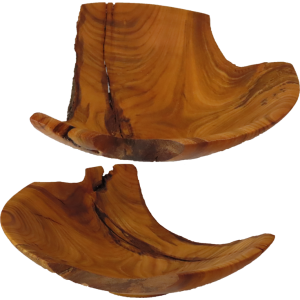 This video is also posted on YouTube, Vimeo, and FaceBook. However, you’re already here!
This video is also posted on YouTube, Vimeo, and FaceBook. However, you’re already here!
I went out to my woodshed and spotted an old apricot crotch that I have been saving “for a rainy day”. The wood is worse off for the time that it has been taking up space in my shed.
I decided to turn it anyway. But after taking safety precautions like a face shield and staying out of the danger zone.
This was scary with bark and wood flying off.
In the end, this is an unique, beautiful bowl.
Enjoy!
Deep Hollowing Green Turned Vase – The Easy Way
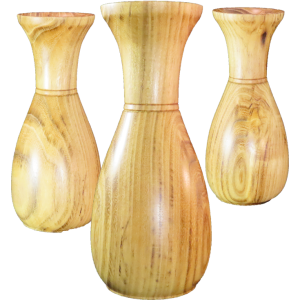 This video is also posted to YouTube, Vimeo, and FaceBook. Where Best? Right Here!
This video is also posted to YouTube, Vimeo, and FaceBook. Where Best? Right Here!
Recently, I’ve experimented with different ways to turn a small hollow vase without doing the hollowing through the small neck of the vase.
This is one of the best options.
I originally rough turned this vase about a year ago. At that time, The rough shape was defined, tenons created, and some hollowing completed before sealing the wood.
After a year of drying, the wood is definitely lighter and dry. I proceeded to complete turning the vase.
What is different this time is the joint. To minimize wood lose at the joint and consequent grain mis-match, I used a separate internal double tenon to rejoin the two pieces together – the base and the neck. This way I could disguise the joint with a very shallow groove and bead.
This and hollowing from the bottom are my preferred joining techniques.
For final hollowing I used a deep hollowing system from the Southern Utah Woodturners club. It is a great system but only provided to members of their club. Commercial equivalents are available.
Some references:
Previous videos (links):
- From Green Firewood To Vase – Deep Hollowing Wet Wood
- Woodturning & Hollowing A Vase – Not Through This Neck
- How To Hollow A Tall Thin Cherry Vase
- Update To My DIY Lathe Steady Rest
Enjoy!
Woodturning Inside Out 3 Stave Art Flame
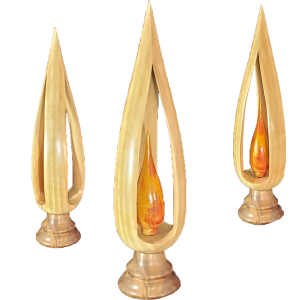 This video is also posted to YouTube, Vimeo, and FaceBook. But you’re already here, aren’t you?
This video is also posted to YouTube, Vimeo, and FaceBook. But you’re already here, aren’t you?
I had not completed a triple inside out turning for quite a while. So, after seeing Dale Dallon demonstrate an inside out flame, I had to jump back into it and incorporate the refinements I saw in his process.
Some of the refinements include:
- using CA glue dots to hold the first set of staves together
- using strapping tape for security
- cutting a groove for alignment when reversing
- rationalizing the wood preparation based on American Woodturner February 2010
Some facts:
- Board thickness(y) divided by 1.732 or thickness times 0.577 = distance to first cut(x).
- For a given board thickness(y), board width of 7 times x plus 2 saw kerfs is needed where x is the distance to the first cut.
- Subsequent cuts are 2x or y divided by 0.866 or y multiplied by 1.155
- A digital angle gauge is a great tool to set blade tilt.
Enjoy!
Decorating End Grain With Sorby Tool-Guest Presentation
This video is also posted to YouTube, Vimeo, and FaceBook. Where Best? Right Here!
Vladimer Swartsman, a fellow member of our local woodturning club consented to sharing his experience decorating end grain with a Sorby Spiraling and Texturing tool.
He shows how to sharpen the tool and how to position the tool for a variety of different textures. Then shows how to make the design strong with some color. Any wood can be textured.
Many thanks to Vladimer.
Enjoy!
Woodturning Spalted Sweet Gum Cross Grain Box
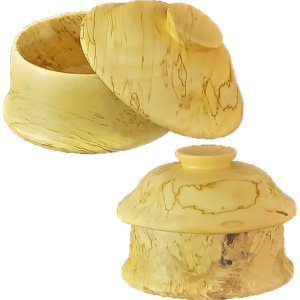 This video is also posted to YouTube, Vimeo, and FaceBook. Where Best? Right Here Already!
This video is also posted to YouTube, Vimeo, and FaceBook. Where Best? Right Here Already!
After a recent demonstration, I decided to turn my own cross grain box. The wood I had available was smaller than that in the demonstration. Yet, I find the spalting in this sweet gum to be quite pretty.
My box is 5 inches in diameter and 4 inches in height, finished with beeswax and mineral oil.
Enjoy!
DIY Triple Wire Woodburner For Woodturning
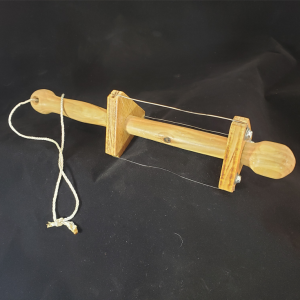 This video is also posted to YouTube, Vimeo, and FaceBook. Where best – Right Here!
This video is also posted to YouTube, Vimeo, and FaceBook. Where best – Right Here!
At a recent Saturday gathering of local woodturners, we discussed wire wood burner alternatives. I’ve used a commercial set for many years but they then to get kinked up; burn me; and are hard to find. After our initial discussion, I did more research. One that impressed me was mounted in an old hack saw. Then why not mount three wires at a time in the same fixture?
My triangles are about 3 inches on a side. Double washers and a screw secure each end of the wire. The wood and finish don’t matter. The exact size of wood pieces don’t matter. The exact wire sizes also do not matter.
So pull one together and start burning lines in wood instead of fingers.
Enjoy!
Turning Inside Out Vase – Not Solely For Ornaments
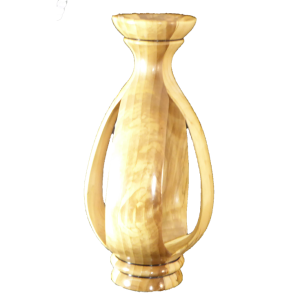 This video is also posted on YouTube, Vimeo, and FaceBook. Best? Right here!
This video is also posted on YouTube, Vimeo, and FaceBook. Best? Right here!
I browsed the web for ideas for a Mother’s Day project. The one that caught my eye was an inside out vase. Perfect. Inside out is fun but moderately challenging.
Four square pieces of wood are temporarily fastened together. While there are many possible ways to fasten them, I find a paper joint does a good job for a four way inside out turning. For a paper joint, a piece of plain paper is inserted into the joint between each of the glued surfaces.
When mounting the glued up blank between centers, try to exactly place the centers at the insersection of the four pieces. Any offset will show up later.
I cut an asymmetric cove with the first mounting for the inside shape. I also sanded and finished the cove.
After splitting apart the wood pieces with taps from a chisel and cleaning up the new mating surfaces, I reversed each piece of wood and glued them together again – permanently.
Then remounted the block and finished turning the new outside of the vase.
The challenges are cutting air between the four slats and visualizing the inside versus the outside.
I also used my DIY steady rest found in this video at this link, “Update To My DIY Lathe Steady Rest”
Enjoy!
Holey Roley Poley Multi-Axis Woodturning
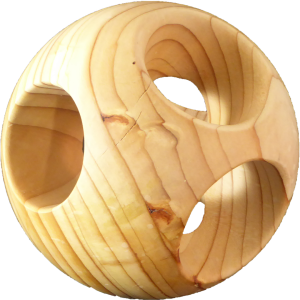 This video is also posted on YouTube, Vimeo, and FaceBook. Where Best? Right Here!
This video is also posted on YouTube, Vimeo, and FaceBook. Where Best? Right Here!
Barbara Dill’s book on multi-axis woodturning is the inspiration for this project. As I looked through the photos, I said to myself, “That can’t be that hard, it’s just a sphere and some holes”. But a doughnut chuck I made several years ago is key to turning the holes.
The wood is Titan cedar finished with walnut oil. It is about six inches diameter.
This is not my best sphere. Please refer to my previous videos for better spheres.
The best is “Woodturning Essentials – Octagon Method For Perfect Spheres”
While not my best sphere, it is my best multi-axis Holey, Roley, Poley.
Enjoy!
Preparing Green Apple Branch For Natural Edge Projects
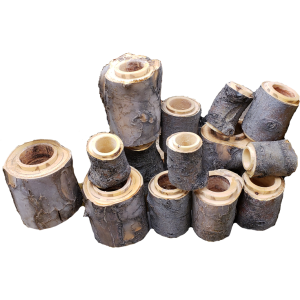 This is also posted to YouTube, Vimeo, and FaceBook. Where Best? – Right Here!
This is also posted to YouTube, Vimeo, and FaceBook. Where Best? – Right Here!
In my Spring pruning, I cut a large limb from my apple tree. I hate to waste good wood, especially apple wood. However, apple is very likely to crack and split. So, it has to be treated.
I decided to cut it into short pieces that could be used for boxes and similar projects. To prevent cracking, I chose to drill out the pith and center wood from each piece.
After they dry, then I plan to remount them and make a variety of projects. However, I have fifteen pieces and not that many ideas to finish them.
I will appreciate your suggestions for finishing these short pieces once they are dry.
Enjoy!
Easter Egg Box For My Easter Bunny Egg Cache
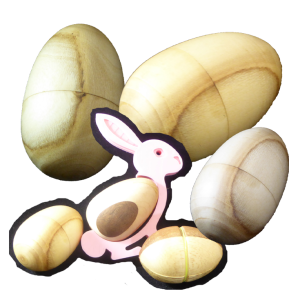 This video is also posted to YouTube, Vimeo, and FaceBook. But you’re already here. Enjoy!
This video is also posted to YouTube, Vimeo, and FaceBook. But you’re already here. Enjoy!
To complete my Easter Bunny’s egg cache, I’ve been working up in complexity from a solid egg to a hollowed paper joint egg, and now to an egg box
This Easter egg is hollow for a small treat inside. A box joint provides access to the treat.
To make this egg:
- Turn a cylinder
- Mark out the egg. Remember than an ideal egg’s length is 1.29 x its diameter and the big end is a hemisphere. Allow more room in the middle for the box mortise and tenon joint.
- Cut a tenon on both ends with some additional allowance to stay away from chuck jaws.
- Part the egg in the middle.
- Mount and hollow one end (I did the large end). The final step is to cut a mortise in this end.
- Mount and hollow the other end. However, include fitting a tenon to the mortise on the other end.
- Put the parts together for final turning, sanding, and finishing.
Remember that you can find a 3D printer at a public library. The STL pattern file is available from Thingiverse.
The perfect egg is reviewed in this video link. (Woodturn My Eggs Easy Over Please).
The wood collet is covered in this video link. (Revisit Woodturning Heart For My Valentine Plus Collet & Jig).
However, while we’re having some Easter fun, please also remember the true reason for Easter.
Enjoy!